Download the report in .pdf
English
Authors: Ida Willig and Mark Blach-Ørsten
December 2016
1. About the Project
- Overview of the project
The Media Pluralism Monitor (MPM) is a research tool that was designed to identify potential risks to media pluralism in the Member States of the European Union. This narrative report has been produced within the framework of the first pan-European implementation of the MPM. The implementation was conducted in 28 EU Member States, Montenegro and Turkey with the support of a grant awarded by the European Union to the Centre for Media Pluralism and Media Freedom (CMPF) at the European University Institute.
- Methodological note
The CMPF cooperated with experienced, independent national researchers to carry out the data collection and to author the narrative reports, except in the cases of Malta and Italy where data collection was carried out centrally by the CMPF team. The research was based on a standardised questionnaire and apposite guidelines that were developed by the CMPF. The data collection was carried out between May and October 2016.
In Denmark, the CMPF partnered with Ida Willig (Roskilde University), Mark Black-Ørsten (Roskilde University), Steen Schaumburg-Müller (Syddansk University) and Søren Sandfeld Jakobsen (Aalborg University), who conducted the data collection, commented the variables in the questionnaire and interviewed relevant experts. The report was reviewed by CMPF staff. Moreover, to ensure accurate and reliable findings, a group of national experts in each country reviewed the answers to particularly evaluative questions (see Annexe 2 for the list of experts).
Risks to media pluralism are examined in four main thematic areas, which represent the main areas of risk for media pluralism and media freedom: Basic Protection, Market Plurality, Political Independence and Social Inclusiveness. The results are based on the assessment of 20 indicators – five per each thematic area:
| Basic Protection | Market Plurality | Political Independence | Social Inclusiveness |
| Protection of freedom of expression | Transparency of media ownership | Political control over media outlets | Access to media for minorities |
| Protection of right to information | Media ownership concentration (horizontal) | Editorial autonomy
|
Access to media for local/regional communities and for community media |
| Journalistic profession, standards and protection | Cross-media concentration of ownership and competition enforcement | Media and democratic electoral process | Access to media for people with disabilities |
| Independence and effectiveness of the media authority | Commercial & owner influence over editorial content | State regulation of resources and support to media sector | Access to media for women
|
| Universal reach of traditional media and access to the Internet | Media viability
|
Independence of PSM governance and funding | Media literacy
|
The results for each area and indicator are presented on a scale from 0% to 100%. Scores between 0 and 33% are considered low risk, 34 to 66% are medium risk, while those between 67 and 100% are high risk. On the level of indicators, scores of 0 were rated 3% and scores of 100 were rated 97% by default, to avoid an assessment of total absence or certainty of risk[1].
Disclaimer: The content of the report does not necessarily reflect the views of the CMPF or the EC, but represents the views of the national country team that carried out the data collection and authored the report.
2. Introduction
Denmark has around 5.7 million inhabitants covering an area of 42,925 km2. The main language is Danish. Denmark has 8.9% immigrants, including a German minority (32,252 people) recognized by the law. Other large groups of immigrants come from Poland (34,537), Turkey (32,352), Iraq (21,182) and Romania (18,732)[2]
The economic situation in Denmark is fairly stable and follows the general trend of the European and Scandinavian countries. The political tradition in Denmark – just as the media system – can be characterized as democratic-corporatist with a strong tradition for including corporations and interest groups in policy making processes. Because of the relatively small language area and a strong public service sector the media market has a high ownership concentration. Denmark has a dual media system with a strong private sector owning newspapers and online media (many receiving public media support) and a strong public service tradition. The public service Broadcaster DR (Danmarks Radio) is mainly financed by licence fees and a central institution in both TV, radio and online platforms. TV 2 offers eight regional TV stations and Radio 24/7 offers national radio – also financed by licence fees.
The Democratic-Corporatist media system are characterized by four conditions which Denmark share with the other Nordic Countries, that is relatively large readership of privately owned newspapers, a relatively high audience reach of public service radio and TV, professional and competitive production of news and views and regulated market conditions based on political compromises[3]. In the 2016 Digital News Report from Reuters this is clearly reflected in both online and offline media use. Thus, the most popular online news media are the two public service television stations followed by the only two Danish tabloids and the two leading morgen newspapers The two public service television stations also dominate offline use followed by local weekly newspaper and Denmark´s only remaining free newspaper.
There are no specific laws in Denmark regarding media concentration, but the issue is covered by the general competition regulation. There have been no legal cases (litigation) regarding media pluralism, or regarding limitations on media pluralism. It is also important to note that the Danish laws on public service radio and television demand diverse programming and that all public service media have editorial freedom. Furthermore, there is a media subsidy system (innovation pool and direct subsidies) for editorial content for the written press online and in print, which is based on a general consideration for media pluralism. The Danish media system has various boards which function independently of the political system and work as defined in law and following their statutory obligations. Finally, pluralism of the media and of content is a general principle of the media laws, especially concerning public service and media subsidies.
3. Results from the data collection: assessment of the risks to media pluralism
The overall result for Denmark is a low risk to media pluralism in three areas: Basic Protection, Political Independence, and Social Inclusiveness. The Market Plurality area is in the medium risk band.
The low risk regarding Basic Protection, Political Independence and Social Inclusiveness could be expected in Denmark, where there is a general focus on the protection of citizen rights as well as the rights of journalists, an overall political consensus to support both privately and publicly owned media, respect for upholding the arms lengths principle ensuring editorial freedom and a general focus on media pluralism and diversity in media policies.
The overall low risk to media pluralism should however not downplay the risk factors documented in this report.
Regarding Market Plurality, the report shows a high risk regarding media ownership concentration and a medium risk regarding cross-media ownership. This can be explained by the fact that the Danish media market (i.e. the area where Danish is the first language) is by nature very small with a population of 5.7 million inhabitants.
Regarding Social Inclusiveness, the overall risk is low, but behind this lies a risk regarding access to media for minorities and for women. Part of the explanation is that there are no quota policies for media as in many other countries. Instead Denmark has a “soft policy” approach focusing on media pluralism and media diversity – but without quantitative measures. The soft policy focus on social inclusion is visible in laws for media support both for privately owned media and public service media.
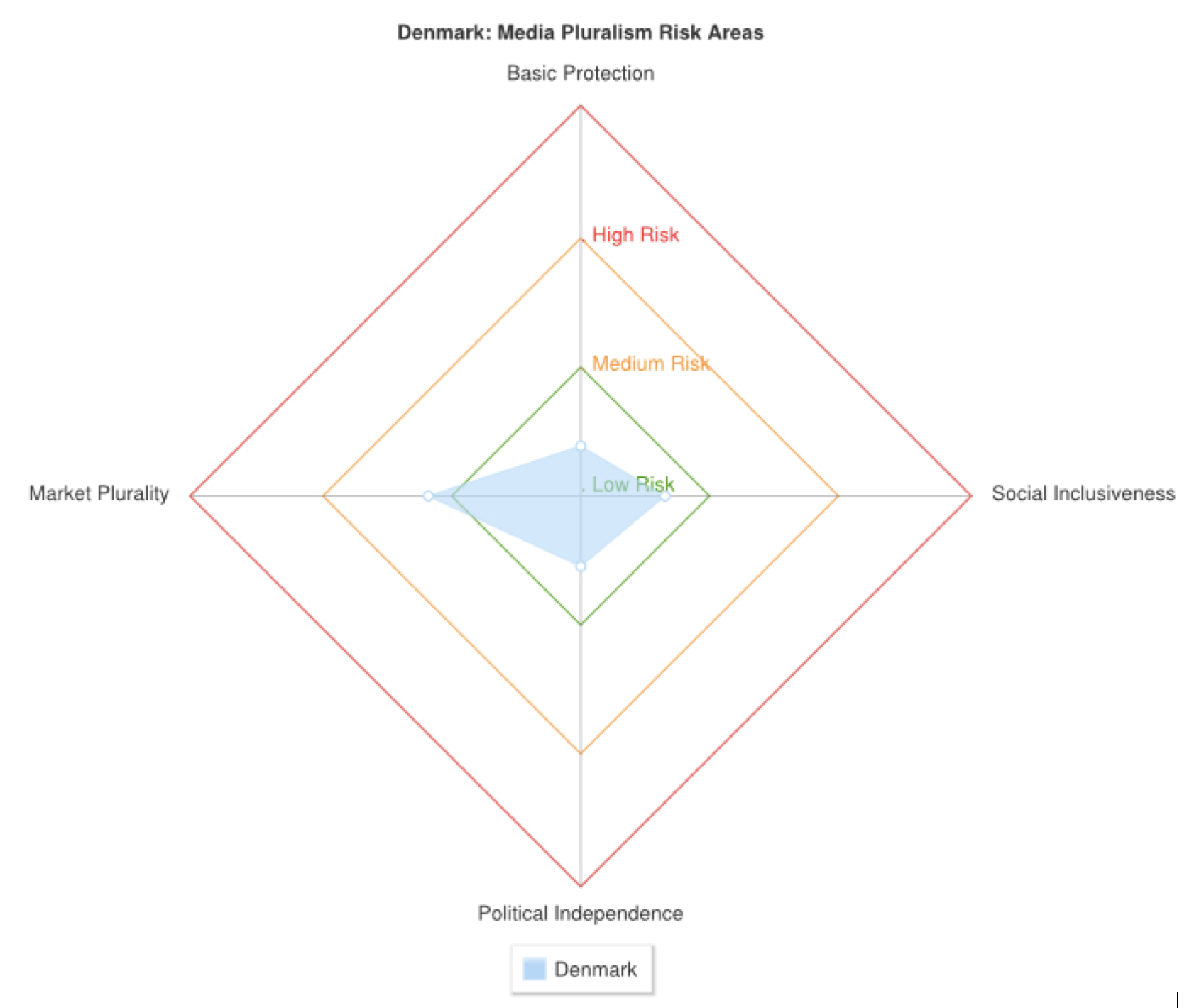
3.1. Basic Protection (13% – low risk)
The Basic Protection indicators represent the regulatory backbone of the media sector in every contemporary democracy. They measure a number of potential areas of risk, including the existence and effectiveness of the implementation of regulatory safeguards for freedom of expression and the right to information; the status of journalists in each country, including their protection and ability to work; the independence and effectiveness of the national regulatory bodies that have competence to regulate the media sector; and the reach of traditional media and access to the Internet.
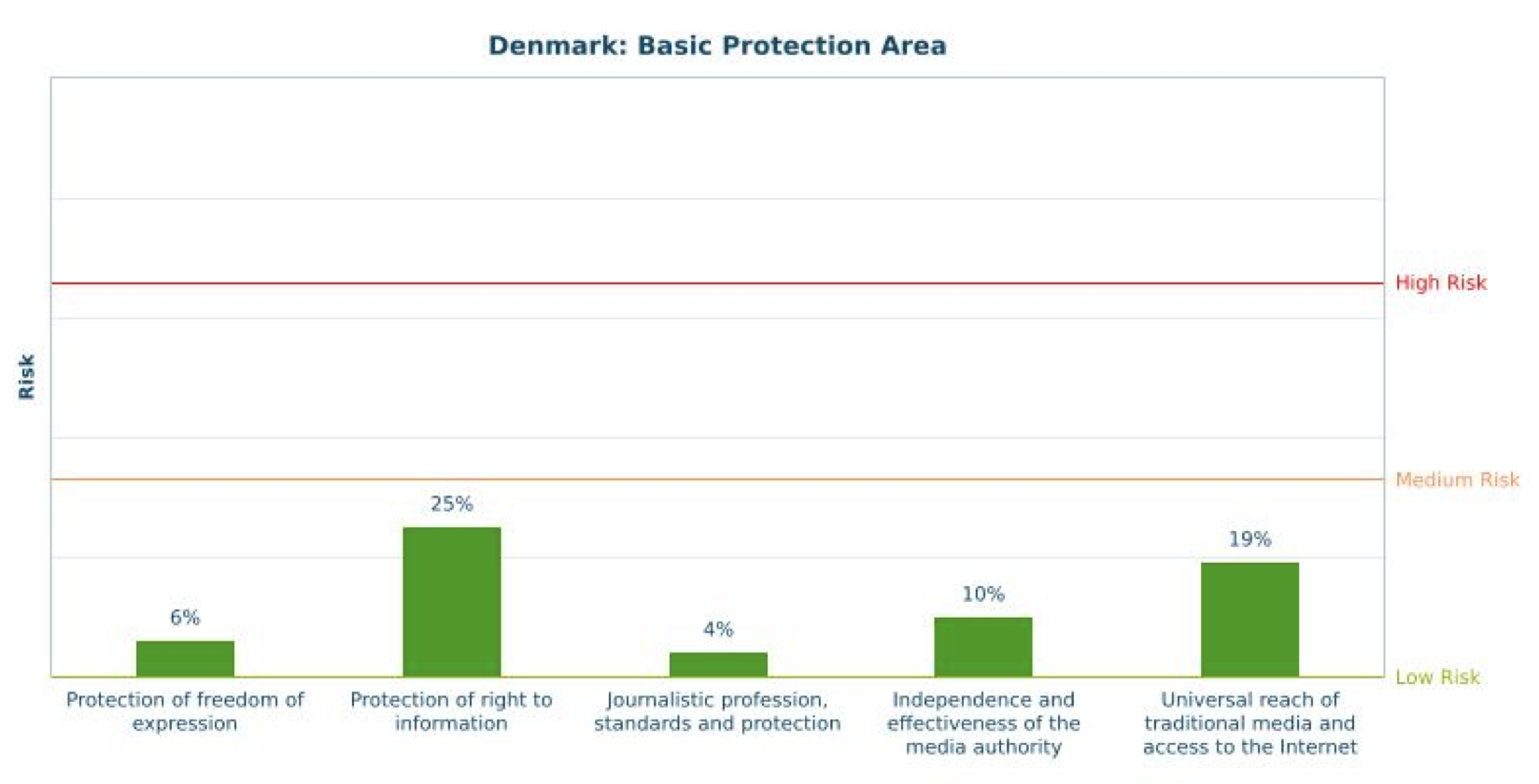
The overall result for the Basic Protection area in Denmark as a low risk in all of the indicators covered by the MPM.
Regarding the protection of freedom of expression (low risk, 6%) and freedom of information (low risk, 25%), the Danish legal system follows the practice of the European Court of Human Rights[4] . As examples the Danish Supreme Court explicitly referred to Jersild v Denmark in a judgment UfR 1997.259H, and in a defamation suit, UfR 2015.3106H, the Supreme Court referred to several ECtHR judgments such as Axel Springer v Germany with a rather in depth analysis and to Ungvary & Irodalom v Hungary. The courts often state that the Danish provisions, which as regards defamation date back to the 1930s, must be interpreted in the light of the ECHR and the Court’s case law.
The indicator on the Journalistic profession, standards and protection shows a very low risk (4%). This is largely due to the strong professional association DJ (Danish journalists) where most journalists are represented and that has a tradition for ensuring good working conditions and protection of professional standards. The access to the journalistic profession is open and transparent and typically goes through one of the three Danish journalism schools, one at an university college and the two others at universities.
The Independence and effectiveness of the media authority also poses a low risk (10%). The Danish Radio and TV Board is an independent institution overseeing if the public service media complies with their public service contracts and licenses. The board controls all public service media both media financed mainly by license fees (DR, The regional TV 2 stations and radio 24/7) and media financed by a combination of subscription fees and commercials (TV 2). The Media Committee (Medienævnet) oversees the public media support for privately owned media and is also an independent institution.
Universal reach of traditional media and access to internet also poses a low risk in Denmark (19%). DR reaches almost all citizens with TV and radio channels, TV 2 is also accessible in all parts of the country alongside the regional stations, and Denmark has a very high internet penetration in all of the country.
3.2. Market Plurality (39% – medium risk)
The Market Plurality indicators examine the existence and effectiveness of the implementation of transparency and disclosure provisions with regard to media ownership. In addition, they assess the existence and effectiveness of regulatory safeguards to prevent horizontal and cross-media concentration of ownership and the role of competition enforcement and State aid control in protecting media pluralism. Moreover, they seek to evaluate the viability of the media market under examination as well as whether and if so, to what extent commercial forces, including media owners and advertisers, influence editorial decision-making.
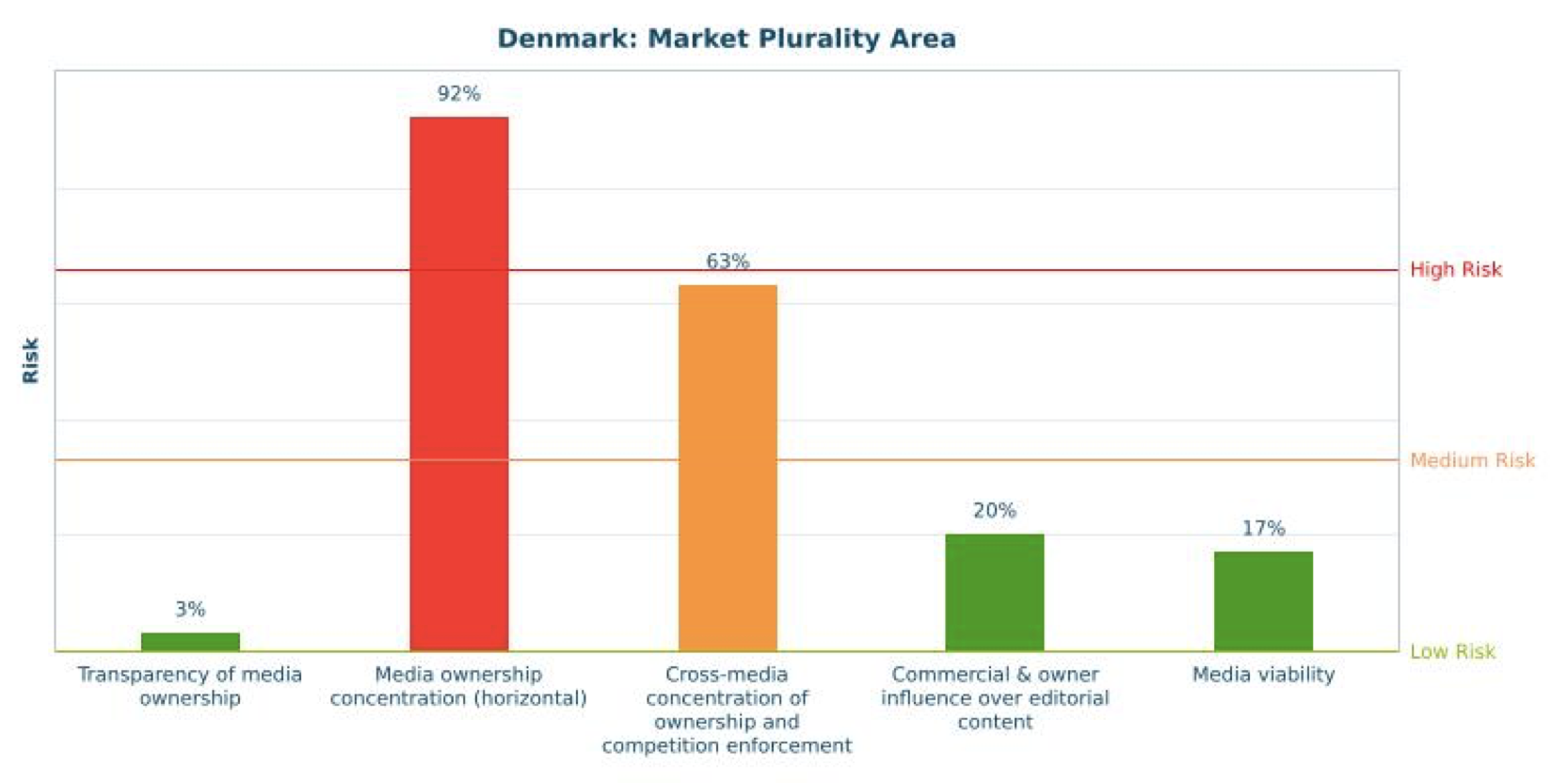
In Denmark, there are no separate rules on transparency for media companies. Instead they follow the general rules as stated in the Financial Statements Act[5]. Private limited and co-operative companies have to state all owners with more than 5% ownership. All ownership above 20% of the shares has to be stated in the annual accounts. The fact that media companies follow the general rules does not mean that there is no transparency or that information is not available. Everyone can access the annual accounts of media companies, although there is a fee at the company register (cvr.dk), and most companies have the accounts on their website. Therefore, the Transparency of media ownership in Denmark poses a very low risk (3%).
The horizontal Media ownership concentration, however, poses a very high risk (92%) together with a medium risk (close to high risk) when it comes to Cross-media concentration of ownership and competition enforcement (63%). This result can be explained by two factors: 1) Denmark is a small media market, and 2) the Danish state is a large domestic media owner, owning the two large broadcasting companies as well as eight regional public service broadcasters (based on license fee funding), with one regional television channel each and regional windows on the largest television channel TV 2, if measured by audience. Furthermore (especially relevant to the cross-media ownership concentration) the largest national news agency (Ritzau) is owned by a large group of media companies including the Danish PS broadcaster DR.
The indicator regarding Commercial and owner influence over editorial content scores a relatively low risk (20%). This result mirrors different characteristics of the Danish media system such as the fact that there are no political owners of newspapers or formal political ties between the political system and the newspapers owned by either commercial owners or not-for-profit foundations, and that the principle of armslength (that owners or boards do not interfere with the editorial decisions) is applied in both privately owned media as well as public service media.
Media viability scores a low risk at 17%. Regarding the relatively small size of the Danish media market, this is a condition with an effect on most media commodities and is especially the case for news media and the production of domestic audiovisual content for instance high quality drama and content for children. As the population is just above 5.6 million there is a limited number of consumers to pay for media content, and as the main language is Danish there is only a very limited market for Danish media productions outside of the country. In order to secure pluralism of media content, there is a tradition of broad political support for the existence of strong public service media and some degree of subsidy for editorial content in printed and online news media as well as subsidies for community radio and television.
3.3 Political Independence (18% – low risk)
The Political Independence indicators assess the existence and effectiveness of regulatory safeguards against political bias and political control over the media outlets, news agencies and distribution networks. They are also concerned with the existence and effectiveness of self-regulation in ensuring editorial independence. Moreover, they seek to evaluate the influence of the State (and, more generally, of political power) over the functioning of the media market and the independence of public service media.
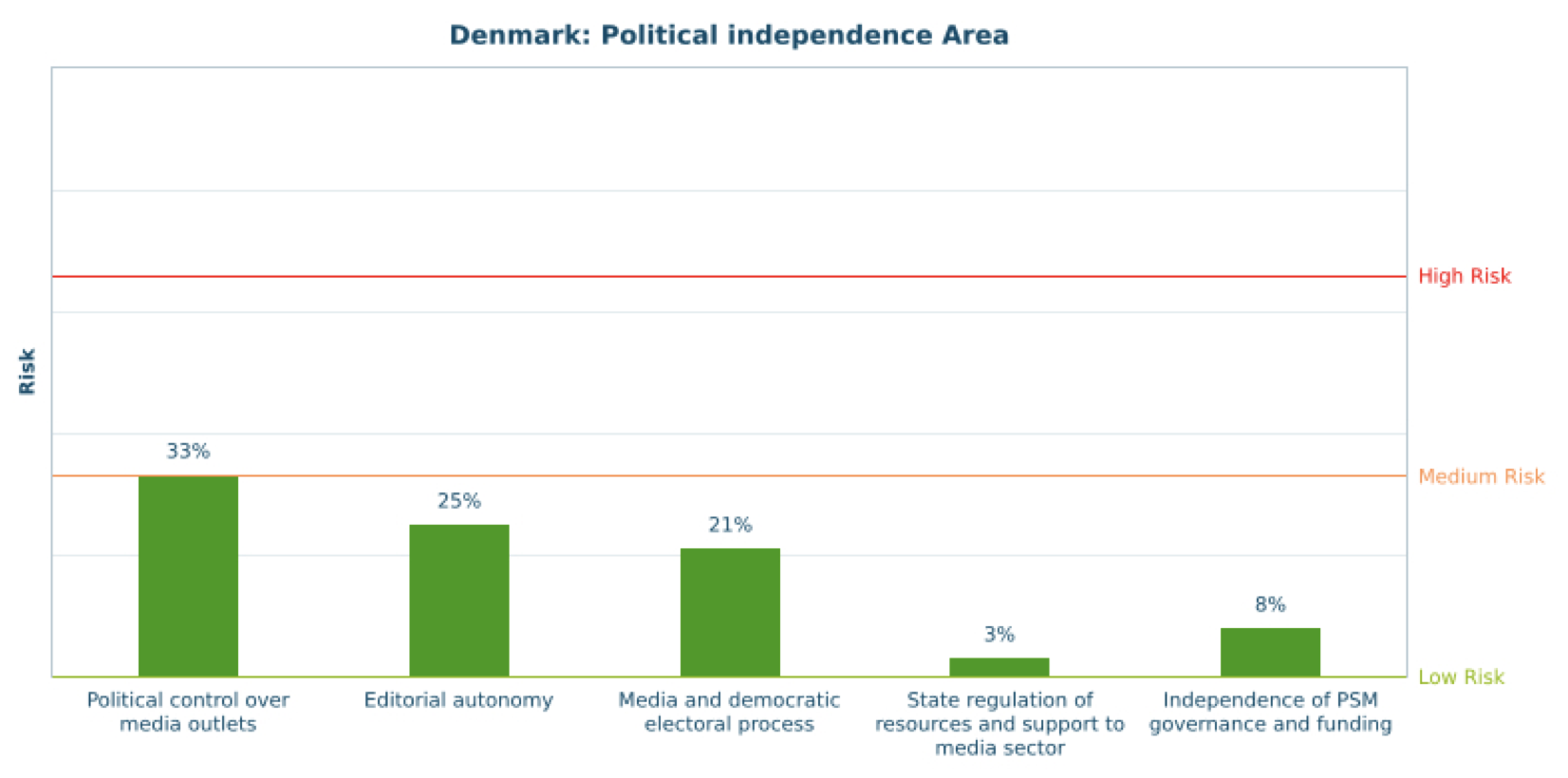
The overall result of the Political Independence area is a low risk.
Regarding Political control over media outlets the risk is at the tipping point between a low and medium risk (33 %). This is due to the lack of specific regulation (e.g. conflicts of interest) but there is no misconduct observed in practice. The printed (and online) press has a tradition of editorial freedom including a freedom to express political opinions and no political parties own newspapers in Denmark.
In the analyses of Editorial autonomy the indicator shows a 25 % risk. This result might seem odd to journalists, politicians and researchers familiar with the Danish media system with a tradition for editorial independency when it comes to both private and public service media. The result however, can be explained by the fact that Denmark does not have a high degree of regulatory safeguards, but relies on the tradition of self-regulation, for instance codes of ethics and codes of conduct, and a very strong institutionalisation of the Danish Press Council (only very few media are not members).
Denmark has different policies ensuring a low risk (21%) when it comes to Media and the democratic electoral process. Some of them can be considered “soft policies” such as a general statement in the public service contract 2015-2018 stating that DR (Danmarks Radio) must “stimulate participation in the public debate and democratic processes”. An example of a more “hard policy” is the total ban of political advertising on Danish television.
The indicator on State regulation of resources and support to the media sector scores a very low risk (3%) highly due to the transparent legislation on media support. Both public service media and privately owned media are eligible to public media support. Public service media are mainly financed by licence fees. This economic model are discussed in public from time to time, but until now there has not been a political majority to change it. Privately owned media – both print and online – are eligible to “production support” if they live up to different criteria relating to the production of quality news content (for instance a certain amount should be original, be of interest to many people, cover different beats etc.). Production support is given to established media but there is also an “Innovation pool” supporting new and innovative news media. The media support policy focusing on “journalistic production” in 2015 replaced a previous policy supporting “media distribution” and will be evaluated after three years in 2018.
The Independence of PSM governance and funding is also at a low risk in Denmark (8 %) mainly due to the general armslengths principle.
3.4. Social Inclusiveness (22% – low risk)
The Social Inclusiveness indicators are concerned with access to media by various groups in society The indicators assess regulatory and policy safeguards for community media, and for access to media by minorities, local and regional communities, women and people with disabilities. In addition to access to media by specific groups, the media literacy context is important for the state of media pluralism. The Social Inclusiveness area therefore also examines the country’s media literacy environment, as well as the digital skills of the overall population.
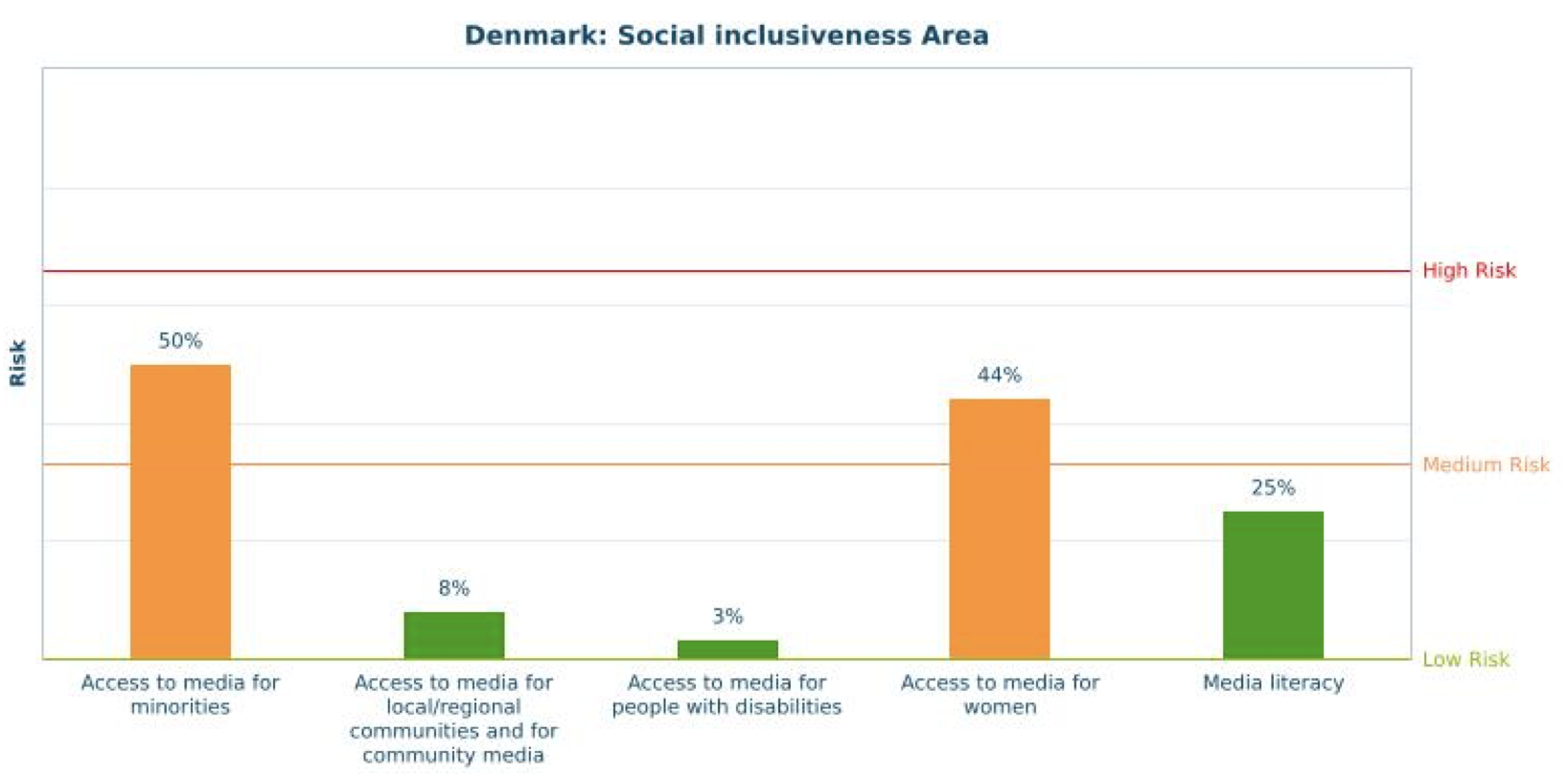
Two indicators in the area of Social Inclusiveness score medium risk: Access to media for minorities (50%) and Access to media for women (44%). This can partially be explained by the fact that Denmark has no quota policies in regard to assuring access for minorities or women to media. Instead, there are “soft policy” guidelines focusing on pluralism and diversity but not operating with quantitative measures such as quota. We also find that a separate explanation to the medium risk regarding the access to media for minorities has to do with the methodology of the MPM, which does not take into account that Denmark is a very small media market with even smaller language minorities, and as such there are no viable markets for a range of minority language media.
As for the general question of social inclusiveness it is important to note that Denmark has a strong tradition of editorial independence and armslength between politicians and media companies, and that public media support – both to PSM and the printed and online press – is given with explicit instructions on pluralism and diversity.
PSM has complete editorial independence and are not limited by law in any way in terms of choosing who should and should not have access to airtime. But at the same time, there is an explicit focus on pluralism and diversity.[6] For instance Article §10 in the Radio and Television act (Article §10) states that “The overall public service activities shall, via television, radio and the Internet or similar, provide the Danish population with a wide selection of programmes and services comprising news coverage, general information, education, art and entertainment. Quality, versatility and diversity must be aimed at in the range of programmes provided. In the planning of programmes, freedom of information and of expression shall be a primary concern. Objectivity and impartiality must be sought in the information coverage. Programming shall ensure that the general public has access to important information on society and debate. Furthermore, particular emphasis shall be placed on Danish language and culture. Programming shall cover all genres in the production of art and culture and provide programmes that reflect the diversity of cultural interests in Danish society.”[7] As such, the fact that various cultural and social groups do not have quota access to airtime should not necessarily be considered a risk indicator but rather an empirical question for further research. For instance, social inclusiveness is directly mentioned in the current public service contract (valid from 2015-2018) where it is stated (own translation) that: “DR must offer a broad societal coverage and reflect the pluralism of culture, ways of life and living conditions in the different parts of the country”[8].
Printed and online newspapers in Denmark also have editorial freedom and no quota policies regarding access for minorities and women. Women increasingly hold executive positions as editors and managers at newspapers and are visible but not strongly represented on the newspaper boards.
Regarding the low risk for Access to media for local/regional communities and for community media (8% risk score), this can partly be explained by the fact that Denmark has a relatively large number of privately owned local and regional newspapers and radio stations, public service funded regional television stations (TV 2 regions) as well as a relatively strong (and recently increased) presence of the PSM DR in regional communities and community media such as local radio stations.
The indicator on Access to media for people with disabilities scores very low risk (3%). Interviews with disability organisations and a review of the PSM provisions in that regard points to a very low risk regarding the access to media for people with disabilities.
The media literacy indicator also scores a low risk (3%). Media literacy is in the curriculum of most education institutions and the Danish press association has a project each year where they work together with schools to enhance knowledge of news media and news media literacy. The expert interview and available sources pointed towards the difficulty of defining and measuring but assessed the risk to media literacy in Denmark to be low.
4. Conclusions
The MPM analysis for Denmark shows a low risk to media pluralism in all four areas covered by the study, both basic protection, political independence, social inclusiveness and – although in lesser degree – market pluralism.
The medium risk in the market pluralism area can for the most part be explained by the fact that Denmark is a relatively small media market. This means that a certain degree of ownership concentration and cross-ownership must be expected.
The general picture of low risk regarding media pluralism in Denmark are not surprising and can be expected in a Nordic country, where there is a general focus on general protection of citizen rights as well as the rights of journalists, an overall political consensus on giving public media support to both privately and publicly owned media while upholding the arms lengths principle ensuring editorial freedom, as well as a general focus on media pluralism and diversity in media policies and media law.
Because of the generally low risk in Denmark the country team has no policy recommendation.
Annexe 1. Country Team
The Country team is composed of one or more national researchers that carried out the data collection and authored the country report.
| First name | Last name | Position | Institution | MPM2016 CT Leader (please indicate with X) |
| Ida | Willig | Professor (mso) | Roskilde University | x |
| Mark | Blach-Ørsten | Professor (mso) | Roskilde University | |
| Sten | Schaumburg-Müller | Professor | Syddansk Universitet | |
| Søren | Sandfeld Jakobsen | Professor (mso) | Aalborg University |
Annexe 2. Group of Experts
The Group of Experts is composed of specialists with a substantial knowledge and experience in the field of media. The role of the Group of Experts was to review especially sensitive/subjective evaluations drafted by the Country Team in order to maximize the objectivity of the replies given, ensuring the accuracy of the final results.
| First name | Last name | Position | Institution |
| Holger | Rosendahl | Director of legal affairs | Danske Medier (Danish Media, publishers association) |
| Peter | Skov | Director of legal affairs | DR (Danmarks Radio, PSB) |
| Per | Jaurt | Associate professor, Aarhus University | Member of the Danish Radio and Television board (regulator of PSB) |
| Poul | Thøis Madsen | Associate professor, Danish Media and Journalism Professional School | Expert on media economy |
| Henrik | Søndergaard | Associate professor, Copenhagen University | Expert on media policy |
| Søren | Sandfeldt Jakobsen | Professor, Aalborg University | Expert on media law |
| Troels | Johannesen | DJ (Danish Association of Journalists)
|
—
[1] For more information on MPM methodology, see the CMPF report “Monitoring Media Pluralism in Europe: Application of the Media Pluralism Monitor 2016 in EU-28, Montenegro and Turkey”, https://monitor.cmpf.eui.eu/
[2] “Immigrants in Denmark 2015” (Indvandrere i Danmark 2015), report by the Danish Statistical Agency
[3] (Brink Lund, 2007:122)
[4] See also the report from the Mediadem project [https://www.mediadem.eliamep.gr/wp-content/uploads/2012/01/Denmark.pdf])
[5] https://www.retsinformation.dk/Forms/R0710.aspx?id=135933
[6] For instance, social inclusiveness is directly mentioned in the current public service contract (valid from 2015-2018) where it is stated (own translation) that: “DR must offer a broad societal coverage and reflect the pluralism of culture, ways of life and living conditions in the different parts of the country”. https://kum.dk/fileadmin/KUM/Documents/Kulturpolitik/medier/DR/Public_Serviceaftale_2015-18/DR_public_service-kontrakt_for_2015-2018.pdf
[7] https://www.retsinformation.dk/forms/R0710.aspx?id=161625
[8] https://kum.dk/fileadmin/KUM/Documents/Kulturpolitik/medier/DR/Public_Serviceaftale_2015-18/DR_public_service-kontrakt_for_2015-2018.pdf
